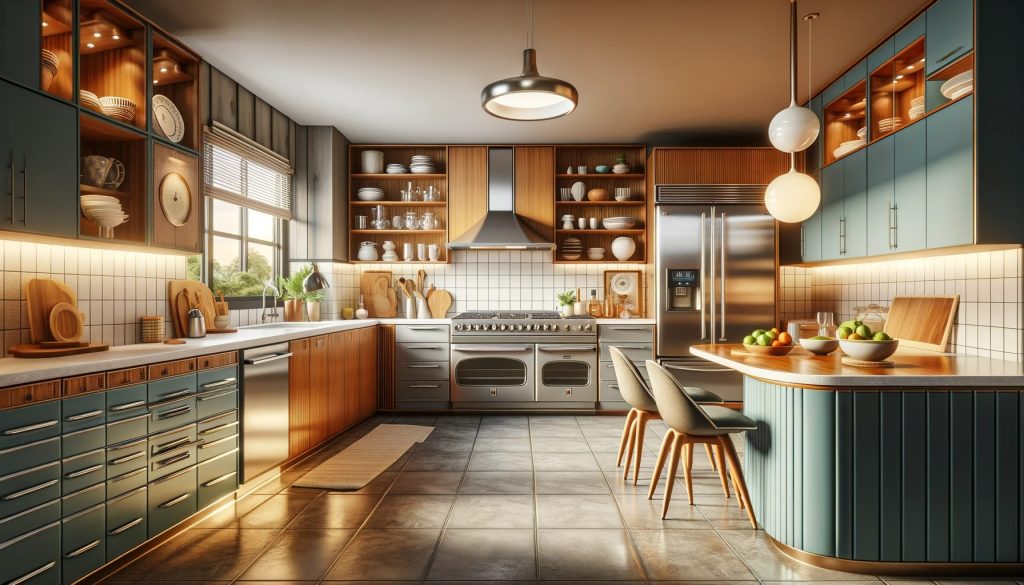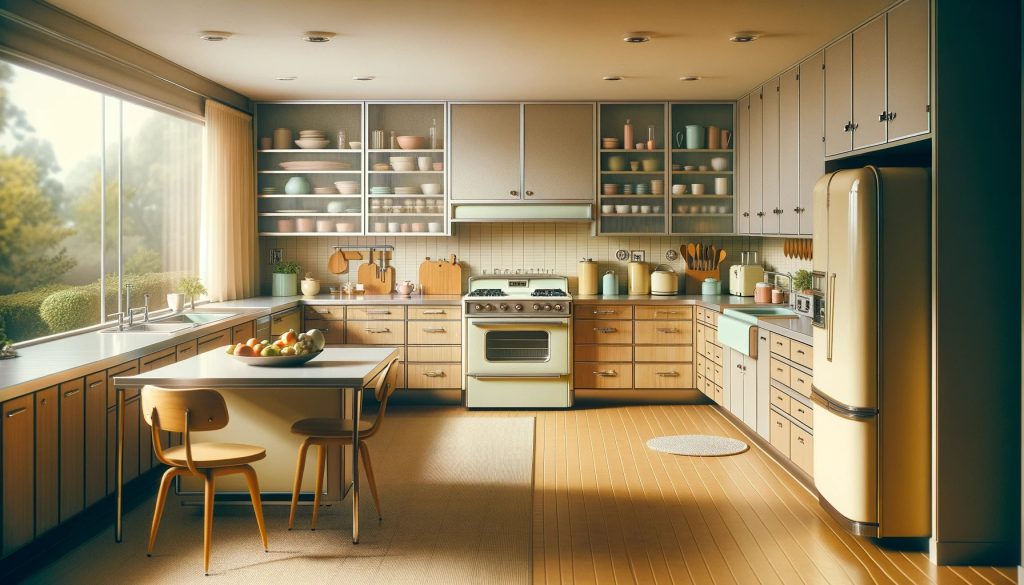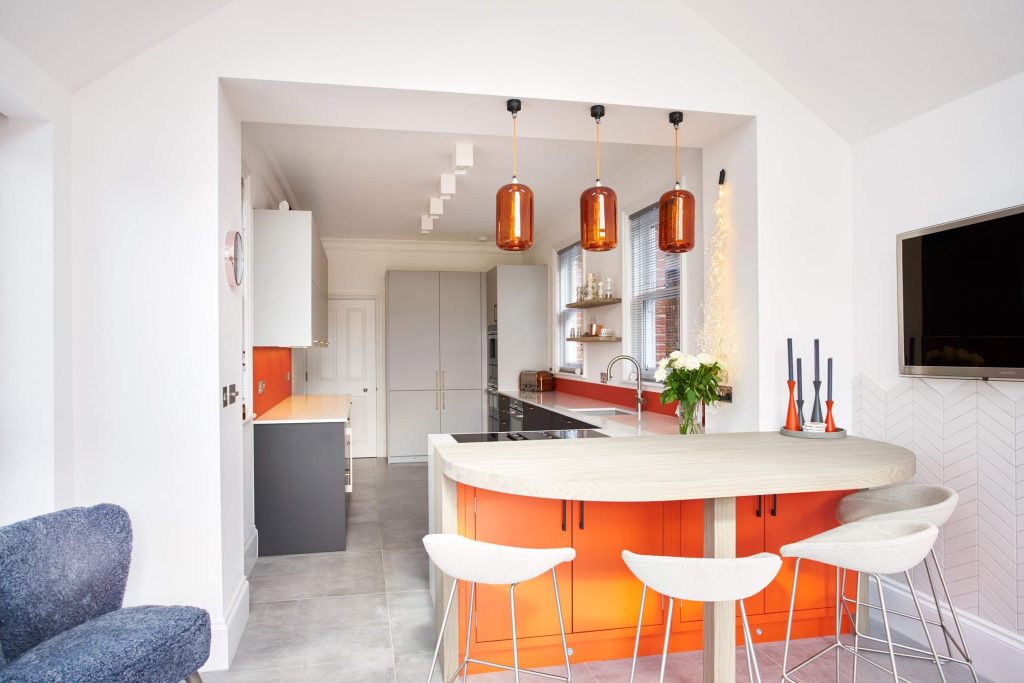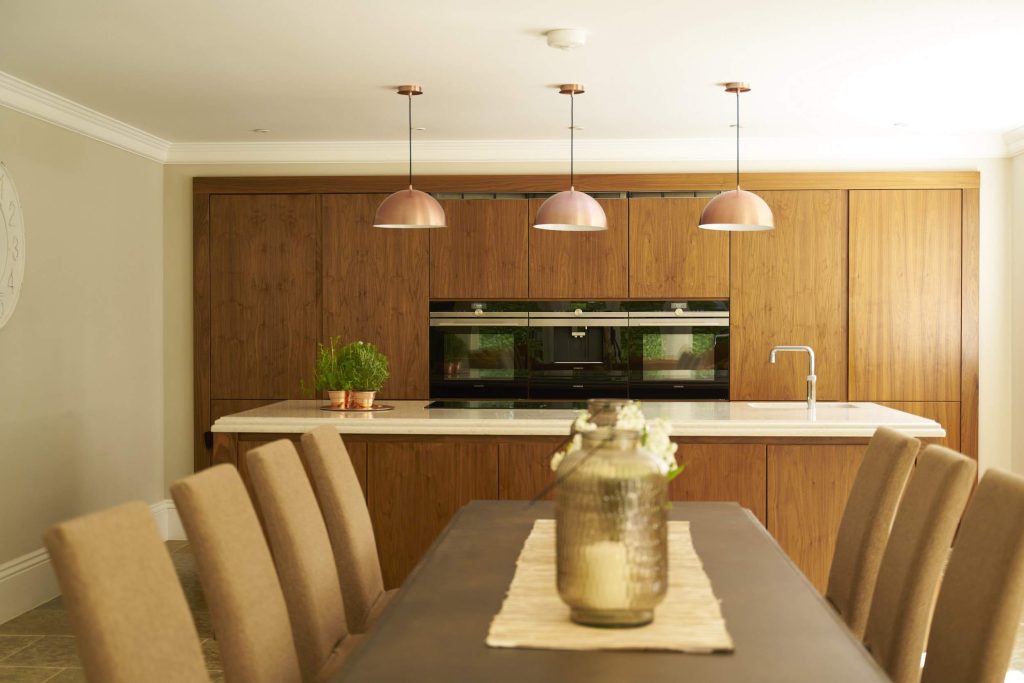Discover the Charm of Mid-Century Kitchen Design with Lead Wolf Kitchens
Mid-century kitchen design is a popular trend that has seen a resurgence in recent years delivering a timeless, stylish look that can add value to any home. Inspired by the aesthetic and architectural movements of the mid-20th century (roughly from the 1940s through the 1960s), this style is characterized by its clean lines and minimalistic features, with a harmony of organic and geometric forms.

What Does a Mid-Century Kitchen Look Like?
Integrating both functionality and understated elegance, mid-century design typically incorporates a mix of natural woods, contrasting colors, and a balance of traditional and non-traditional materials. The emphasis is on creating a warm, inviting, and highly functional space that echoes the forward-thinking spirit and optimism of the post-war era.
So, whether you are revamping an existing kitchen or starting from scratch, the mid-century kitchen design offers timeless appeal, marrying vintage charm with modern sensibility to craft a kitchen that’s far more than a cooking space, but a tribute to a truly iconic era.
The Evolution of Mid-Century Kitchen Design
The mid-century kitchen design movement emerged in the 1950’s and gained popularity throughout the following decades, proving a refreshing pivot from the ornate kitchens of earlier eras. Instead, this style embracing modernist influences with an emphasis on simplicity, functionality, and the integration of cutting-edge materials and technologies. Key figures in mid-century kitchen design included pioneers such as architect Charles Eames, who led the charge with the introduction of sleek materials like formica, stainless steel, and glass. He was also a champion of innovative appliances and space-saving storage solutions. With a clear goal, Eames vision was to combine form and function to create timeless, efficient kitchens accessible to all, a legacy that resonates in contemporary kitchen designs today.


Mid Century Kitchen Features
As well as simplicity and functionality, the mid-century kitchen design movement also placed an emphasis on the integration of nature and the outdoors. Large windows and open floor plans were common in mid-century kitchen design, allowing for an abundance of natural light and a connection to the surrounding environment. And, as the mid-century kitchen design movement evolved, it began to incorporate more colorful and playful elements, such as bold patterns and pops of color. This added a sense of fun and personality to the functional and minimalist aesthetic of mid-century kitchen design.
Today, mid-century kitchen design remains a popular and timeless choice, with many homeowners and designers incorporating elements of this style into their kitchens. Its emphasis on simplicity, functionality, and the integration of nature continue to make it a desirable and enduring choice for kitchen design.
The Importance of Functionality in Mid-Century Kitchen Design
Functionality is a key element of successful mid-century kitchen design and one way that mid-century kitchen design achieves this functionality is through the use of well-planned storage solutions. This might include the incorporation of drawers and cabinets with built-in organizers, as well as the use of open shelving to create a sense of openness and accessibility.
Another way that mid-century kitchen design emphasizes functionality is through the incorporation of new technologies and appliances. These might include energy-efficient refrigerators, dishwashers, and ovens, as well as smart appliances that can be controlled and monitored remotely.
In addition to the functional aspects of the kitchen itself, mid-century kitchen design also focuses on the functional layout of the space. This might include the placement of appliances and storage solutions to create an efficient workflow, as well as the incorporation of seating and dining areas for entertaining and everyday use.
Overall, the importance of functionality in mid-century kitchen design cannot be overstated. By creating a kitchen that is efficient, practical, and well-planned, homeowners can enjoy a space that is beautiful, but also functional and enjoyable to use on a daily basis.


How to Incorporate Mid-Century Design into Your Kitchen
Mid-century kitchen design seamlessly melds both style and functionality, drawing its inspiration from the iconic design trends of the 1940s through the 1960s. Working with our kitchen design experts at Lead Wolf Kitchens we can help you navigate the following elements to successfully incorporate this timeless aesthetic into your kitchen: –
- Consider the layout: The layout of your kitchen plays an important role in incorporating mid-century design. Consider the placement of appliances and storage solutions to create an efficient workflow, as well as incorporating seating and dining areas for entertaining and everyday use.
- Sleek Materials: Opt for sleek and modern materials like formica, stainless steel, and glass, which are quintessential to mid-century design. These materials add a sense of sophistication and style to the kitchen but also help to create a clean and streamlined look.
- Natural materials: As well as sleek materials, Mid-century kitchen design often incorporates natural materials, such as wood and stone countertops and backsplashes, to add warmth and texture to the space. These materials help to balance out the sleek and modern elements of the design and create a sense of harmony.
- Openness: One of the key features of mid-century kitchen design is an open floor plan that allows for an abundance of natural light and a connection to the outdoors. Large windows, sliding doors, and open floor plans are all common elements of mid-century kitchen design. Open shelving also offers a way to create a sense of openness and accessibility. Adding open shelving to your kitchen can help effect an appealing mid-century look.
- Efficiency and Functionality: Beyond aesthetics, a mid-century kitchen prioritizes functionality. Ensure well-planned storage solutions by incorporating built-in organizers in drawers and cabinets, and consider wall-mounted storage options. When selecting kitchen appliances, choose those with clean, unadorned lines to maintain the minimalist charm.
- Pops of Colour: While mid-century kitchen design is often associated with a muted and minimalist color palette, it can also incorporate pops of color to add personality and interest. Incorporate vibrant appliances, backsplashes, or accessories to inject personality and dynamism into the space.
- Clean Lines and Balanced Proportions: Embrace designs characterized by clean lines, devoid of excessive ornamentation, creating a sleek yet practical look. Additionally, pay attention to maintaining balanced proportions within the kitchen—this pertains to the harmonious relation between appliances, furniture, and the overall kitchen space.
- Balanced proportions: In mid-century kitchen design, it is important to achieve a balance of proportions between the various elements of the space. This includes the balance between the size of the kitchen itself and the size of the appliances, furniture, and other elements within it.
By melding these elements, you’ll create a kitchen that resonates with the timeless appeal of mid-century design, ensuring both style and practicality.
Bringing the Mid-Century Look into the Modern Kitchen
Whilst the Mid-Century kitchen look holds widespread appeal, designers recognise that many homeowners may be hesitant to fully commit to a mid-century kitchen design, as it can seem overwhelming or out of place in a modern home. Thankfully, there are ways to incorporate the mid-century look into a modern kitchen in a way that is both stylish and practical. At Lead Wolf our designers can work with you to create the exact look and feel you want for your kitchen. For example, we know an open floor plan and the incorporation of large windows can help create a connection to the outdoors, a common element of mid-century kitchen design, whilst bringing this look into a modern space. Similarly, adding pops of color through colorful appliances, backsplashes, and accessories can achieve a modern look. And again, choosing appliances and fixtures with clean lines and a minimalist aesthetic can help to create a cohesive mid-century look without committing to a full mid-century kitchen renovation.


Book a Free Kitchen Design Appointment Today
To find out more on how you can create a stylish and practical kitchen incorporating the timeless aesthetic of mid-century design contact our friendly team of Gotham kitchen design experts today.







